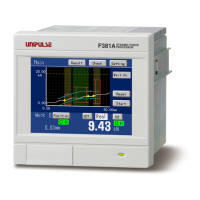60
4 SETTINGS AND CALIBRATIONS
60
SETTINGS AND CALIBRATIONS
Chapter
4
② To set Detection Interval A, press , and to set
Detection Interval B, press , and then set a value. After
setting A and B, press .
- Detection Load Difference
Set the load difference between Load A and Load B.
Setting range (1 to 19998)
Main screen→Setting→Work Setting→Hold Setting→Use Hold→Inflect.
→Load Difference
① Set the inflection point you want to take. Touch the graph area or specify with the cursor
keys, and then press .
② To set Load A, press , and to set Load B, press
, and then set a value. After setting A and B, press
.
- Detection Start Load
Set the load to start the detection of Inflection Point.
If you do not use Detection Start Load, press .
Setting range (-9999 to 9999)
Main screen→Setting→Work Setting→Hold Setting→Use Hold→Inflect.
→Start Load
How to detect an inflection point
The amount of change in the indicated value at
Detection Interval A (load A) and the amount of
change in the indicated value at Detection Interval B
(load B) are compared, and when Difference C
between these loads exceeds the Detection Load
Difference set value, point a is held as an inflection
point.
If there are two or more inflection points in the hold
section, the point with a larger amount of change is
held.
Normally A=B, but if A<B with a gradual inclination,
it becomes easy to detect the inflection point.
Load
Time or
Detection
Start Load
Load B
Inflection
AB
Load A
C
Load A
Detection Start
A: Detection Interval A
B: Detection Interval B
C: Load Difference
Held as an inflection point
if C>Detection Load Difference.
point a
displacement

